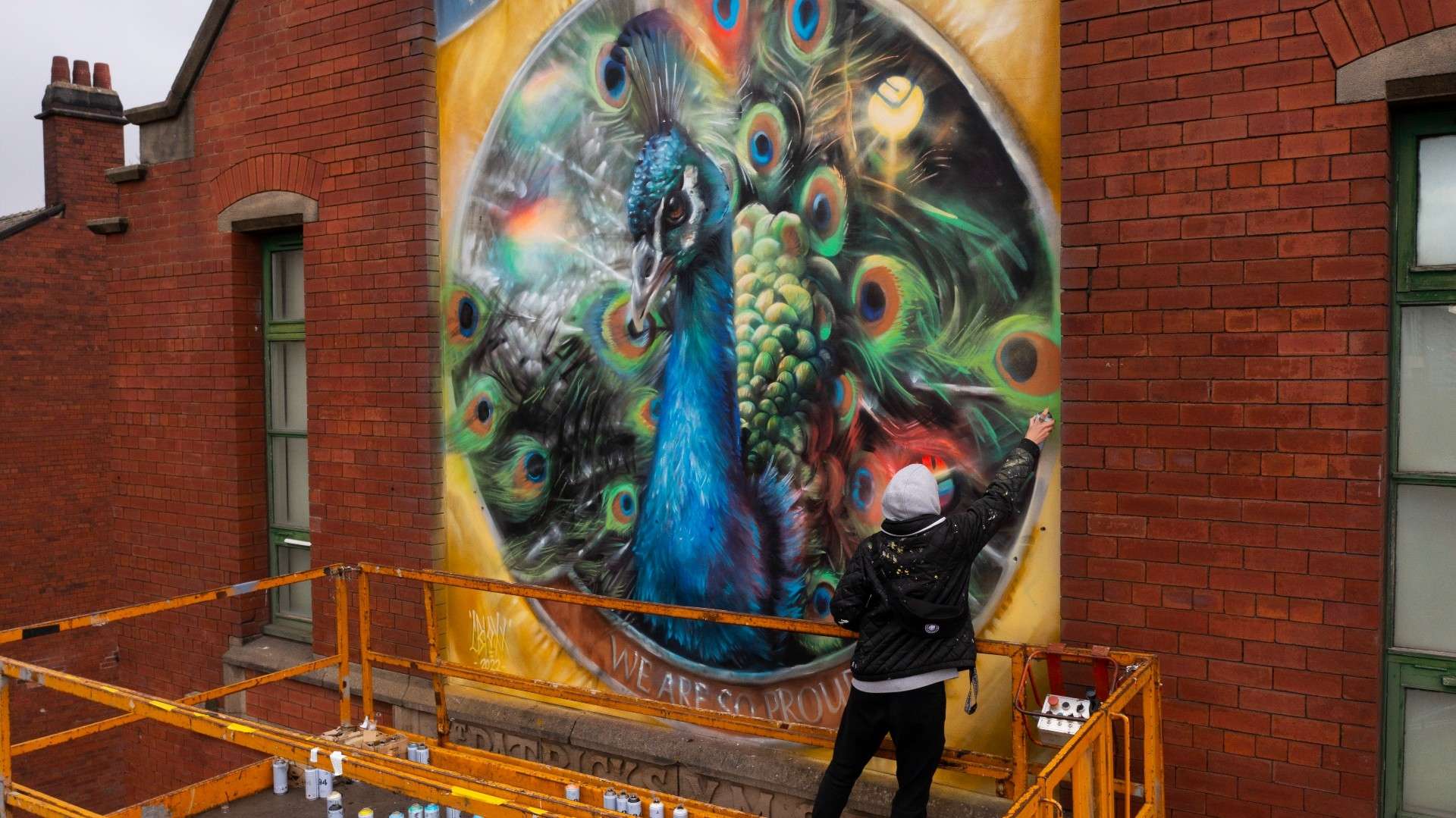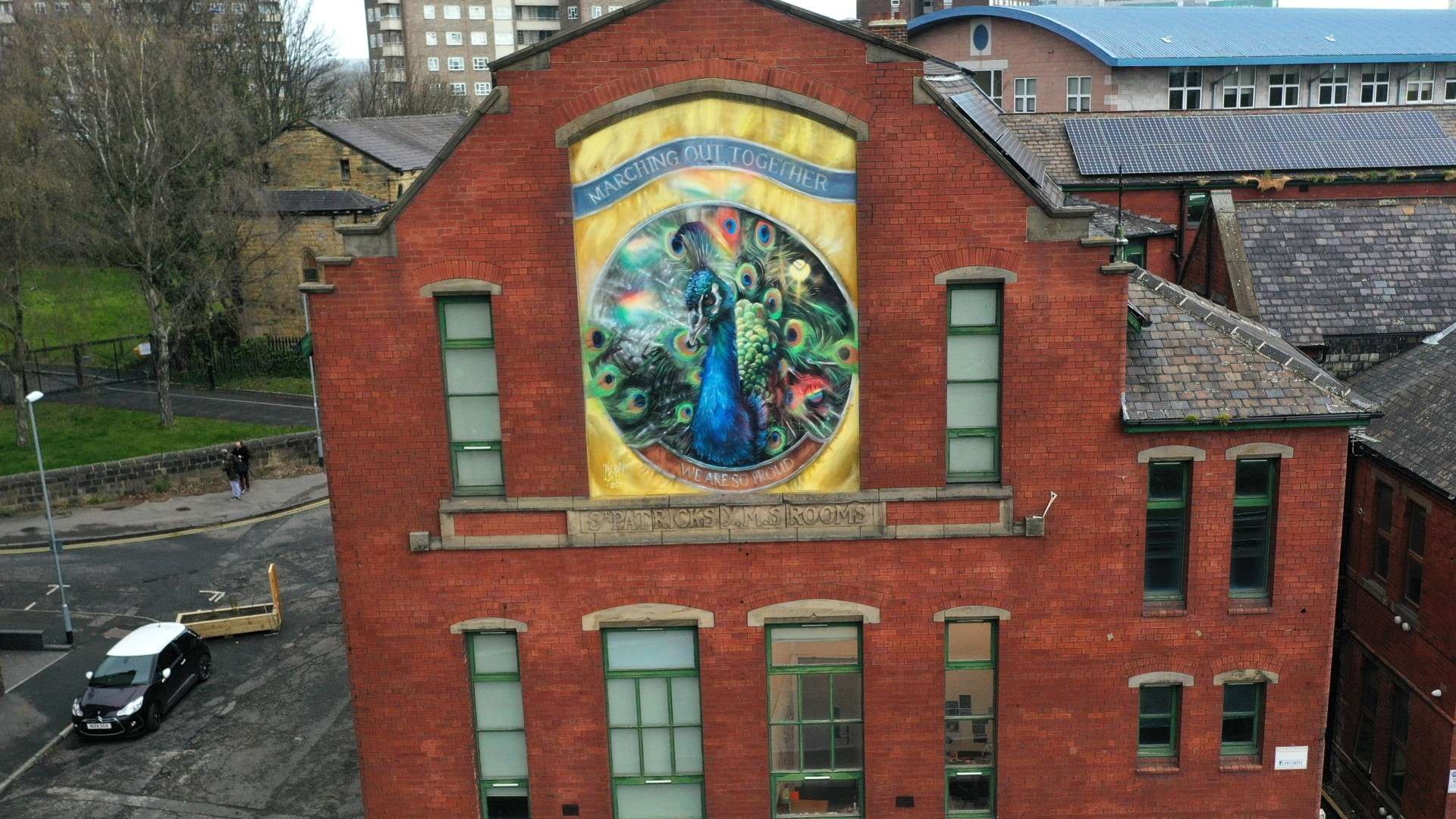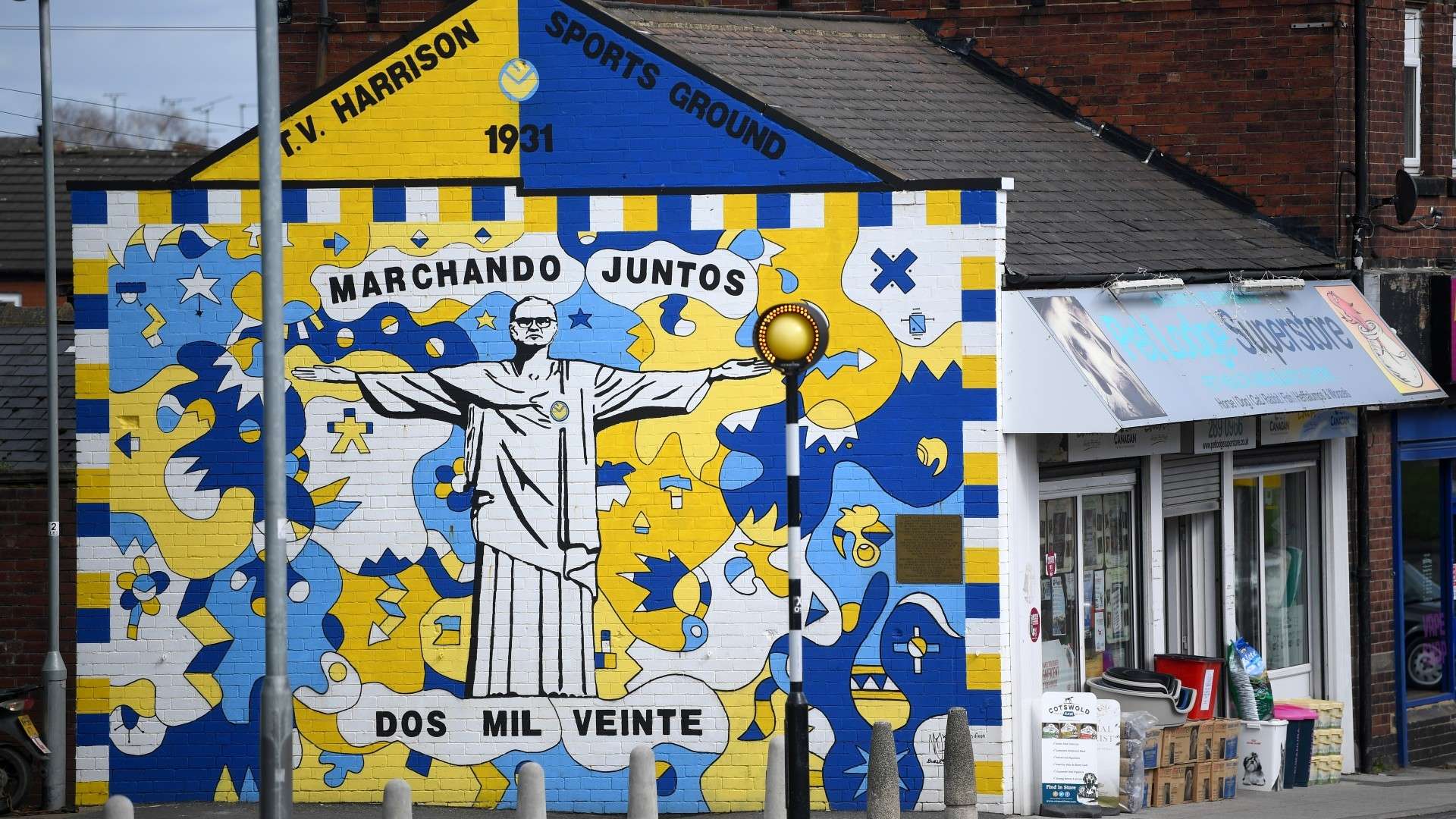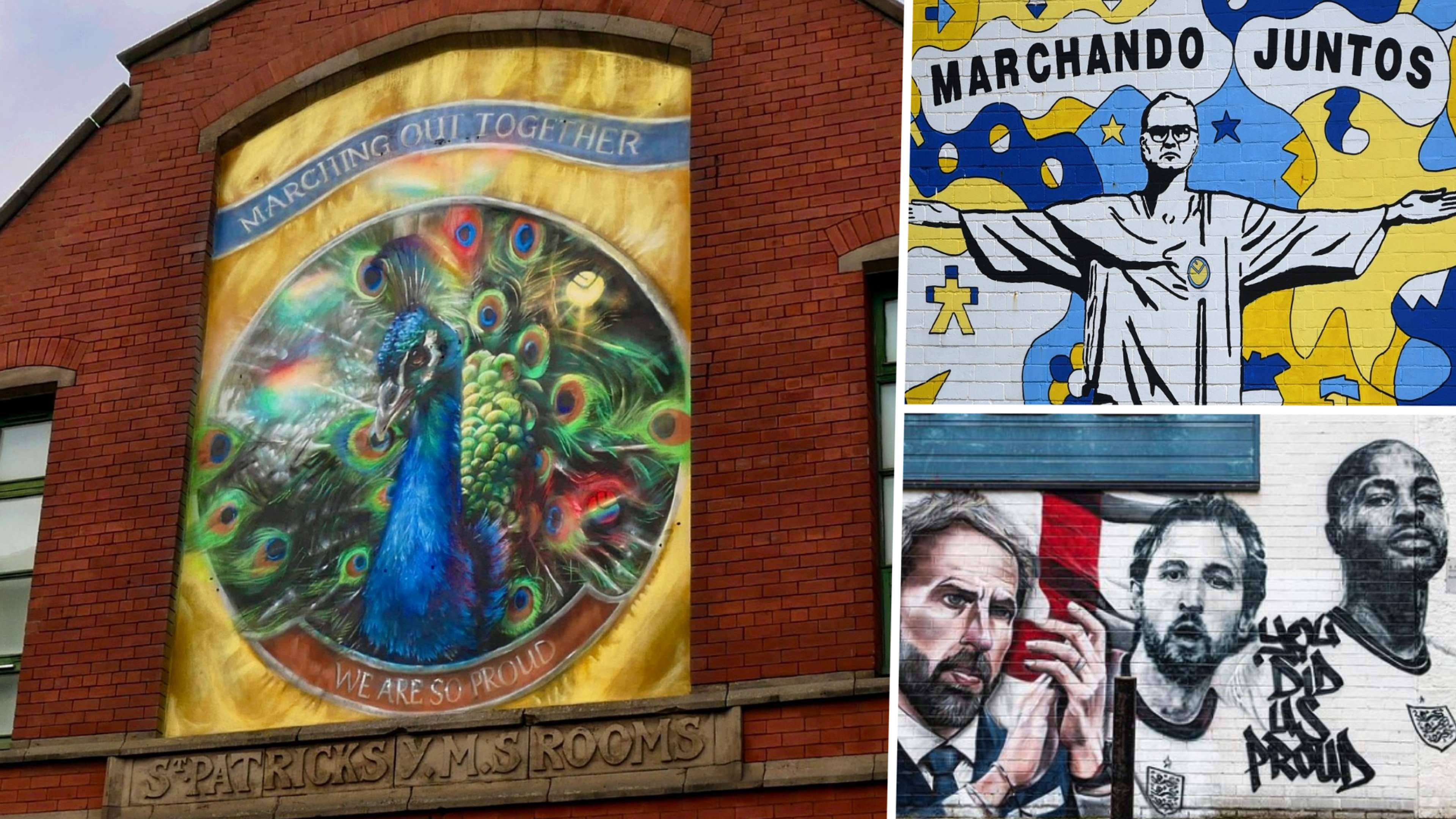Whether painted hundreds of feet tall on the side of a building or sprayed impromptu overnight, whether sombre in black and white or a celebration in glorious technicolour, murals and street art celebrating British football and footballers are more popular than ever.
Artwork has been used to celebrate and demonstrate the changing nature of football fandom - no longer are supporters just drunken middle aged men hurling abuse from the terraces, but people from all races, communities and backgrounds, and street art - inherently guerilla and off-mainstream by its nature.
Similarly, footballers are becoming symbols of something different in society, figureheads of change and voices of a new generation, as demonstrated by artwork such as the Marcus Rashford mural in Manchester.
_-_25.04.2022_-_Final_-_16x9_-_High_Res_(1_of_16).jpg?format=pjpg&auto=webp&width=3840&quality=60) Beats
BeatsRashford in the last month has been the subject of another piece of artwork in the north-west city, created by local artist, Reuben Dangoor, in response to the online scrutiny Rashford faces.
Dangoor said: “The piece was created to try and show the two worlds that Marcus is currently dealing with. On social media he is both abused and celebrated. It must be tough for anyone."
So why has street art become such a popular way of celebrating modern football? GOAL has spoken exclusively to artists and those involved in bringing these murals to life, to discover the true relationship between art and football...
 Jessica Rogers
Jessica Rogers'It's a sassy looking peacock!
In early April 2022, a new mural was unveiled in northern Leeds dedicated to progress towards LGBTQ+ inclusivity in football, and celebrating the LGBTQ+ fan group for Leeds United, Marching Out Together.
The mural depicts a peacock, an animal closely associated with Leeds United ever since the 19th century - the Old Peacock pub has right next to their Elland Road stadium since it was built.
The mural, which depicts a male peacock with his rainbow plumage and has the phrase emblazoned "Marching Out Together", adorns the East Street Arts studio on York Road, and is designed to illustrate the union of football fandom and queer culture.
For artist CBLOXX, marrying those two elements was not something which came easily.
"Initially, I felt like I was hunting for the links between the two [football and LGBT+ people]," they said, speaking exclusively to GOAL. "This is from my own experience of not being a football fan and not feeling like there was space within it for somebody like me.
"The notion of visibility is paramount, it is the only way people who have any sort of phobias change their opinions.
"I came at it from an angle of wanting to create a piece of art that has a purpose, that marries these two worlds. This is something that is within football but is hidden - we still don't have any Premier League footballers who are out, for example. It still speaks of a level of shame, and it is something we have to recognise."
Despite originally being from Huddersfield, just a stone's throw from Leeds and in the heart of the football-mad county of Yorkshire, CBLOXX - aka Jay Gilleard - found themselves struggling to accurately represent the true nature of fan culture in their art.
 Jessica Rogers
Jessica RogersIt was through working with Marching Out Together that they found a way of accurately represent what it means to be a Leeds fan and be LGBT+ - while evading some stereotypes.
They said: "I had to find a starting point that suited my visual aesthetic and could sit within my portfolio. I didn't want it to look like an advert, I don't feel comfortable with that, I wanted to honour each element.
"My starting point is always research, looking at the history and heritage of the club. I wanted the peacock as the centrepiece and then added other elements; there was a marching drum at one point, but then I checked in with the group [Marching Out Together] and they told me how they take the p*ss out of fans who use drums. I had to keep referring back so I didn't run away with ideas of what football fans are supposedly like.
"I wanted it to be about celebrating who you are, and hitting on the peacock as something Leeds is so affiliated with, I couldn't think of anything more appropriate.
"I also wanted it to be enjoyed by people who aren't football fans; it's about being proud of yourself, proud of your community, whatever it might be. It has to serve a purpose of uniting people."
Having come out as non-binary in 2020, CBLOXX has a personal connection to this mural too, with it helping to represent their own journey from someone who would actively avoid football as a child to someone who, earlier this season, finally attended their first ever fixture,
"We are seeing growth and progression within football - growing up as a kid in the 80s, I think if football were more diverse and celebrated the way it is now, I would have embraced it a lot more," they say.
"I'm from Huddersfield, and my association with football as a kid was to stay out of town on match days, there would be fights everywhere - I never felt I had a place within it. That is now being addressed, there is a different vibe, but there is a lot of work to be done.
"One thing that has kept me going has been meeting back up with MOT - I got to see some football [Leeds' 1-1 Premier League draw with Southampton], it was my first ever match. I missed the Southampton goal though as I was getting a pie, I have my priorities.
"I came out as trans at the beginning of the pandemic, and went on this weird isolated personal journey, but while that was happening this job came in, so I have a personal connection too."
 Emma Smith
Emma SmithThe piece was a labour of love for CBLOXX, involving more than 100 cans of spray paint and a constant battle over weeks with the inclement and indecisive British late winter weather - not to mention technical and mechanical difficulties.
They said: "It's been a good year we've been trying to organise getting this together - we tried to schedule it for when the weather would have been better, and we got maybe two days of sun, then it started snowing.
"The scissor lift only reached halfway up, then the replacement broke - hundreds of weird nuggets have slowed it down. Those things make it more memorable - I'm used to things going wrong a lot on these projects!"
Positioned over the main road leading into the centre of one of England's largest cities, the mural will be viewed by millions of people over time. What does the artist hope people will think and feel when they see it?
"I hope firstly it makes people smile - it's a sassy looking peacock! I also hope a sense of pride, a sense of belonging, a sense of place, and a sense of connectivity."
 Getty
Getty'A time and a place encapsulated'
Since attending his first Leeds United game in 1982, Nicholas Dixon has been a devoted fan of the club - which meant he took their 2004 relegation from the Premier League, subsequent financial implosion and nearly two decades in the lower league wilderness harder than most.
As an experienced street artist, there were fewer better placed than him to celebrate Leeds' return to the Premier League in 2020, and particularly the idolised manager that the fans of the club held almost solely responsible for their rebirth, Marcelo Bielsa.
In the days after Leeds' promotion, Dixon painted one of the most famous murals in world football, the depiction of Bielsa as Christ the Redeemer, in the pose and clothing of the Rio de Janeiro statue.
Telling GOAL of his inspiration, Dixon says: "I've followed them through the ups and downs. With Leeds in the lower divisions for 16 years before Bielsa, they were in such a rut with everything.
"Bielsa brought not just a completely different style of football, but a different philosophy to life. He made everybody proud, and respectful of their fellow human beings.
"The spot where I painted it, my friend has a pet shop there, and we have spoken over the years about doing something there. As soon as we got promoted, I went down the next day and got it painted within a week.
"It's more than a football mural, it represents things which go far beyond football, and hopefully it will be there for many years even if Bielsa is not. The least we can do is paint him as the saviour."
The mural went viral on Twitter and attracted news attention around the world, and remains in Leeds to this day - even if Bielsa, sacked amid a poor run of form for Leeds in 2021-22, is not.
Bielsa departing Elland Road makes the mural even more relevant and important now, says Dixon, as the meaning of the art has changed, with the primary feeling upon viewing switching from joy and hope to nostalgia with a twinge of sadness.
 Getty
Getty"It resonates now even more deeply, and gives people time to reflect on what he achieved at the club and what he brought to the city," he says. "Each person has their own individual relationship with Bielsa - that was the beauty of him as a human being; you didn't need to meet him, but he had that mystique.
"It's a time and a place which has been encapsulated."
Dixon is currently awaiting permission from local authorities to paint a new mural in Leeds city centre to celebrate 50 years since United won the FA Cup. It marks a departure from his old outlook which was to keep his loves of art and football separated - something he credits to the modern role of the footballer as cultural icon, rather than simply a sports star.
He says: "I was always a little bit wary of doing football murals from an artist's point of view, but now you have a lot of people like Rashford standing up and making a difference, and people want to honour him by painting his face on a building. It's not just a football statement, it's on a humanist level.
"There is a changing face of football; going back a few years when I was painting on the streets, I didn't want to get typecast with football murals, but now it isn't just about a load of lads going on a Saturday afternoon on the p*ss, it has moved on.
"It is much more inclusive now; I go watch my nieces playing football on a Saturday morning and they love it. The murals reflect how our world is changing, and that can only be a positive thing, while keeping that tribality element of football, reminding you of where you are and who is around you."
Dixon's relationship with Bielsa is not over, as he hopes to go over to Argentina and the manager's home city of Rosario. There, Newell's Old Boys have named a stand after him and where Bielsa paid for the training facilities.
"I'd love to paint him as Christ The Redeemer in his home city, combining the Leeds and the Newell's colours," says Dixon.
And what of perhaps the most controversial element of the statue - that by painting Bielsa in the style of Christ the Redeemer, he is crossing the streams of the most volatile rivalry in South American football?
"Painting him as an iconic statue, the fact it's Brazilian and he's Argentinianm was tongue in cheek," insists Dixon. "A nod to the rivalry between those two countries.
"That raised a few eyebrows! But art is supposed to create debate, especially when you are putting public art out about something as tribalistic as football.
"Icon is definitely the word for Bielsa, he goes away knowing he has been celebrated."
'We didn't know what we would be painting'
Why are murals increasing in number and popularity? Marc Silver, CEO of Murwalls, has a simple answer: "Murals are the new statues."
Silver has run Murwalls since 2020, designing the work which is then put in place by artists in a range of locations, from football stadiums to bedroom walls.
They have become one of the mainstream faces of the football mural movement, with clients ranging from the BBC to a host of Premier League clubs, including Liverpool, West Ham, Brighton and Watford.
Among their most notable works are the mural of Jordan Henderson lifting the Premier League trophy after Liverpool's Premier League title triumph in 2020. "The night he lifted that, we were waiting in the scissor lift," Silver tells GOAL. "Henderson came down the next day and signed the wall."
Another was a mural of Gareth Southgate, Harry Kane and Raheem Sterling unveiled in London to pay tribute to the England team after their Euro 2020 final defeat against Italy; the Three Lions manager, captain and star forward accompanied by the words: "You did us proud".
The piece appeared the morning after the defeat on penalties, amid a storm of racist abuse sent to Marcus Rashford and Bukayo Saka after they missed penalties in the shoot-out. Silver explains how they were able to turn around the work so quickly.
He says: "We were introduced to the Greater London Authority (GLA) a few months before the Euros, which turned into them wanting something if England won the competition. I was more sceptical - I'm a West Ham fan, I'm used to disappointment.
"There was a Plan A and a Plan B - Plan A, if we won the Euros, was to paint a mural all around Wembley; Plan B was to do something just to mark the tournament. It was only at the quarter finals where we took it seriously, it suddenly became a lot more realistic.
"We had a WhatsApp group with people from the GLA, we kept in touch throughout the match, then in the disappointment of losing on penalties, everyone just disappeared off the group, and I was left wondering what we were doing the following morning. The next day me and two of our artists turned up at London Bridge at 6am, and we didn't know what we were painting.
"We weren't able to create an image of the whole squad, which we felt was completely deserving, so we had to highlight the talismans - Southgate was obvious, Kane and Sterling had scored most of the goals. We came up with that design literally on the spot.
"I thought it would get a nice reaction, but it was crazy, the love that piece still gets now is huge, the way it has worked out is absolutely fantastic."
Silver thinks that murals can represent the most visceral elements of how football fans feel about their team, while also providing a permanent artistic landmark like statues - but unlike statues, are less susceptible to a slip of the hand from the sculptor.
"Statues have been built for years, and this is the 21st century of creating these honours," he says. "There have been a few questionable statues as well too, so with street art we can create something which is more realistic. People are also amazed with the talent of the artists out there, what they can create with a spray paint can, it blows people's minds. We want that wow factor, the appreciation of the art and the appreciation of the player.
"I have massive pride in seeing what we have done and the timescale in which we do it, and the reaction of people, it's quite emotional. The only thing that would come close would be scoring the goals that inspire the art."
Murwalls most recently painted a mural of Ledley King at Tottenham and are next planning an Ian Rush tribute in Liverpool, and Silver thinks that this is a trend which is here to stay.
He says: "It coincides with acceptance - because it's done with a spray can, this could have been classed as graffiti in the past. However with the skills and talent involved it can't be called that in a negative way any more. We can thank people like Banksy for paving the way for street art being an accepted art form. I feel we have a huge hand in that, we've done around 20 football murals in the last two years and we have a huge amount more in the pipeline.
"Liverpool are really the trendsetters on this, you don't have too many other big clubs with a hardcore football fanbase living right by the ground. You have people in these terraced houses around Anfield who are besotted by football, this is their life. You have these big gabled ends of these terraced houses in Liverpool, it's a great opportunity. I get people calling me up now saying, 'I've got an end of terrace house, would you be able to paint it?'"
Whether in Liverpool or elsewhere, we should expect plenty more football murals to come.
